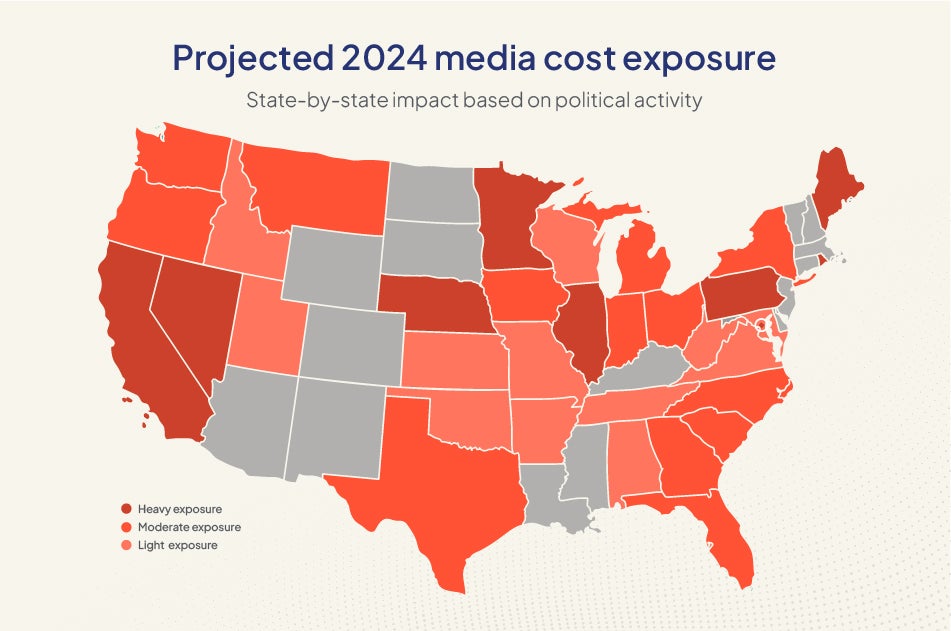3 tips for getting the most out of your advertising spend in 2024: Part 3
Editor's Note: This article is the third in a three-part series looking at how healthcare marketers can strategically use their advertising spend amid some unique challenges in 2024.
3 tips for getting the most out of your advertising spend in 2024: Part 1
3 tips for getting the most out of your advertising spend in 2024: Part 2
Election year or not, one thing does remain the same: Advertising spending is all about timing. It’s just that this year, you may need to be more flexible than usual. Be prepared to shift your media calendar to accommodate the many disruptions of 2024 races, and still be able to see the ROI you need.
The fourth quarter will be a “perfect storm” of ad spending.
Fourth quarter is traditionally competitive, but this year is expected to be massive in terms of ad spend, with what some media buyers are coining the “Q4 Armageddon.” Across all industries, marketers are vying to squeeze every last drop out of their marketing budgets before the end of the year. Spending events such as Black Friday, Cyber Monday, and the overall holiday season are annual impacts. But this year, with the Presidential election and Medicare’s annual open enrollment period (which takes place October 15 through December 7), these huge spending waves are all cresting at the same time. It’s no surprise that some media outlets may be taking advantage of the massive spike in advertising demand, and raising rates accordingly.
In speaking with a number of media partners, some shared that they are seeing an unprecedented rate spike. Buyers are already booking and securing Q4 avails, earlier than ever before, and paying rates 65% higher year over year, if not more.
Tip #3: Time the market right by looking at your local and state calendars.
“Consider the county, district, and state in which your audience resides,” says Lindsey Weissenbach, MSM, Manager, Programmatic Strategy and Technology at WebMD Ignite. “Are they in a swing state (or states), or high-stakes market? If so, you may have to be extra nimble with every dollar, particularly during certain times of the year.”
With this expected to be a record year on political ad spend, projections show that the area to see the most activity is by down-ballot candidates, at $3.3 billion.2 So starting at the state level, we took a look nationwide to see what drivers or exceptions may account for larger stakes when compared to the 2020 election year. What we found is that 33 states and the District of Columbia are expected to see a disproportionate impact in 2024. Within this, 12 states appear to have moderately higher exposure, 16 significantly higher, and six dramatically higher.

For example, Virginia appears to have similar races and landscape to the 2020 elections, so we anticipate spending impact will be light, although still impacted by record spending levels. Pennsylvania, on the other hand, had no senate races in 2020. The presidential race appears to be a toss-up there and heavy spending on congressional campaigns is expected with the seventh, eighth, and seventeenth congressional districts, since all are National Republican Congressional Committee (NRCC) and Democratic Congressional Campaign Committee (DCCC) targets. This translates to your non-political ads joining the fight for ad placement and a possible bidding war. And even if your target audience doesn’t reside in a state where we expect to see a moderate-to-dramatic impact on media costs, if you are actively marketing across state lines, even if only 10 miles on either side of a border, this could definitely change the picture for your campaign.
See how your state may be affected in 2024
Because hospitals and healthcare providers mostly advertise locally, they are one of the categories that get crowded out of advertising space the most by political candidates.2 So, how can you mitigate the impact? Consider the calendar of local elections and statewide primaries. For example, March is a particularly hot time for statewide primaries with “Super Tuesday” and its 874 delegates up for grabs.3 And although dates are subject to change by legislative action, June and August are looking to be the busiest months for state primaries.4 Bottom line: Be aware of when your market is on the schedule, and make adjustments to avoid these high-traffic times.
A final thought
However you choose to pivot this year to avoid the spending tsunami, one thing remains clear: it’s never good to go dark. Instead, it’s all about pacing, placement, and targeting to keep your lines of communication with the market open.
Want to start from the beginning and understand how to optimize your ad spend this year? We’ve created a comprehensive white paper that you can download here.
SOURCES:
1 The Guardian. Record $15.9bn in US political ad spending expected for 2024. https://www.theguardian.com/us-news/2023/dec/08/2024-election-ad-spendi…;
2 Chicago Booth Review. How All Those Political Ads Affect Commercial Advertising. https://www.chicagobooth.edu/review/how-all-those-political-ads-affect-…;
3 NBC News. 2024 Primary Elections Calendar. https://www.nbcnews.com/politics/2024-primary-elections/calendar
4 Federal Voting Assistance Program. Primary Elections by state and territory. https://www.fvap.gov/guide/appendix/state-elections




